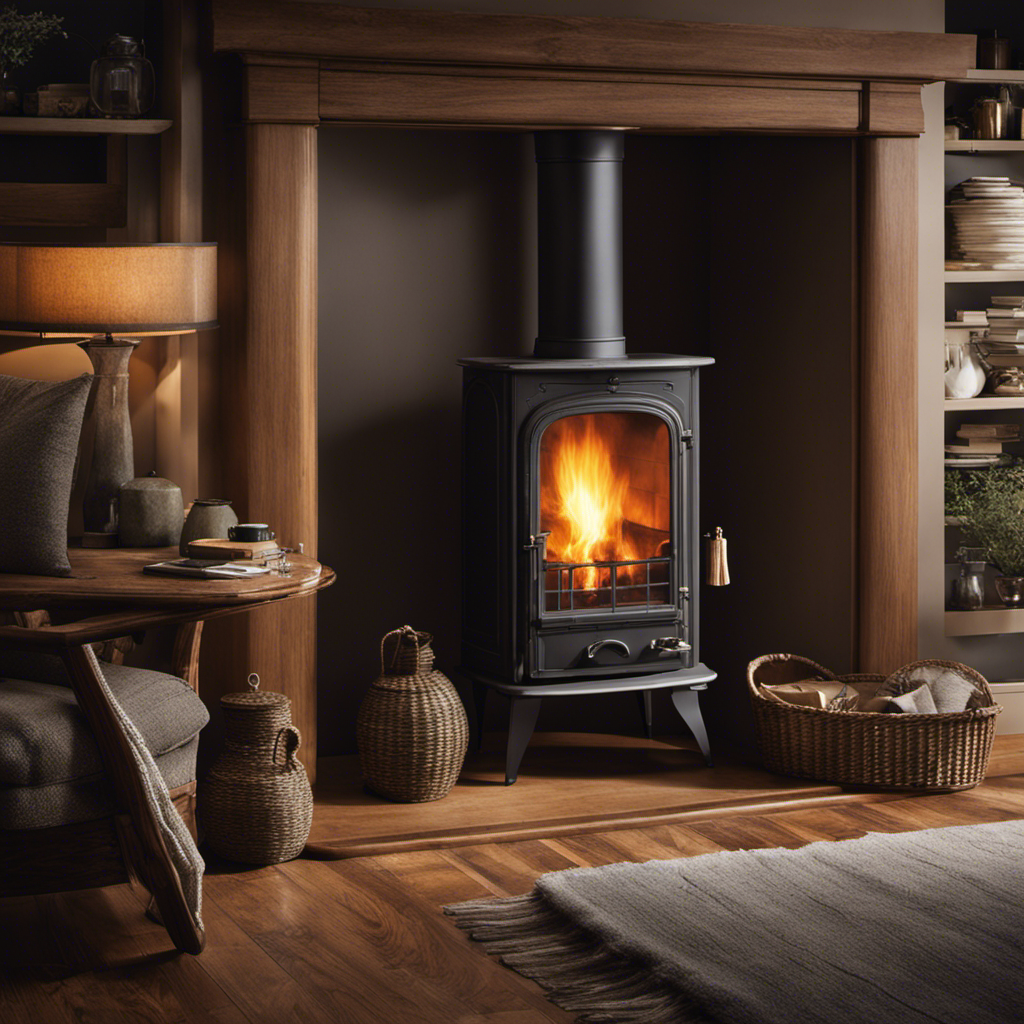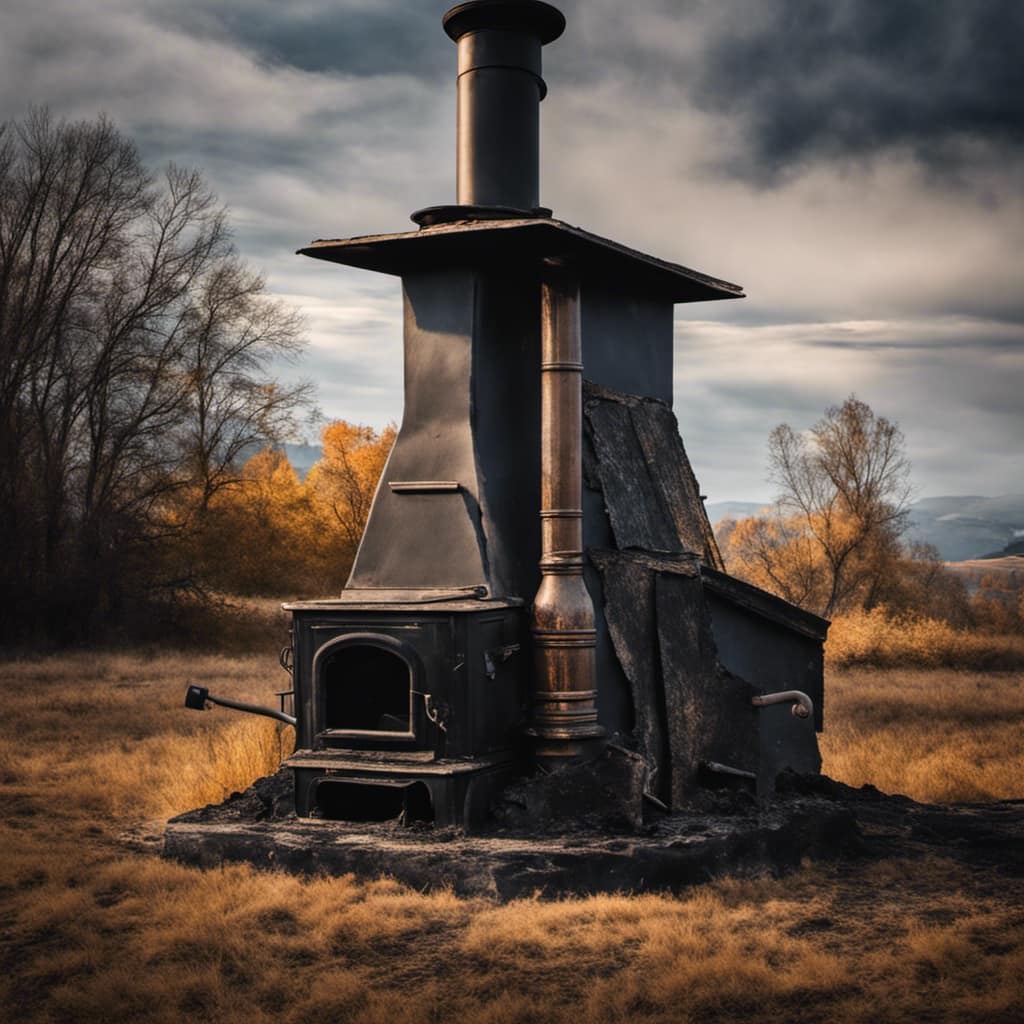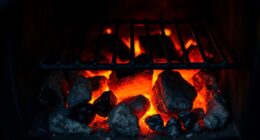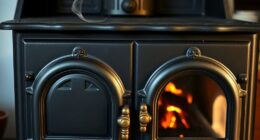When I opened the door and the damper of my wood stove, I was met with an unexpected situation: smoke was billowing out of the chimney. But, what could be the cause of this?
In this article, we’ll explore the possible causes and provide solutions to improve airflow in your wood stove.
From addressing insufficient draft to adjusting damper settings and ensuring properly seasoned firewood, we’ll help you troubleshoot the issue and create a more efficient and smoke-free wood stove experience.
Key Takeaways
- Combustion issues and inefficient burning can cause smoke when opening the door and damper.
- Properly seasoning firewood and ensuring the correct moisture content is essential to reduce smoke production.
- Improving airflow in the wood stove by checking for blockages, adjusting the damper and air intake, and maintaining proper ventilation can help reduce smoke.
- Regularly cleaning and maintaining the chimney, including removing blockages and installing a chimney cap, is crucial for efficient smoke ventilation.
Possible Causes of Smoke When Opening the Door and Damper
I sometimes experience smoke when I open the door and damper, and I’m wondering what could be causing it.
One possible cause of this issue could be combustion issues. When the wood stove isn’t burning efficiently, incomplete combustion occurs, leading to the production of smoke. This can happen if the wood isn’t properly seasoned or if the airflow in the stove is restricted.
Another potential cause could be door seal problems. If the door seal is worn out or not properly sealed, air can leak into the stove, disrupting the combustion process and causing smoke to escape through the door and chimney. It’s important to regularly check and replace the door seal to ensure a tight seal and prevent smoke leakage.
Insufficient Draft: How to Improve Airflow in Your Wood Stove
To improve airflow in your wood stove, open the damper and adjust the air intake knob. This will allow more oxygen to enter the stove, promoting efficient combustion and reducing smoke production.
However, if you’re still experiencing smoke issues, there are a few troubleshooting steps you can take:
-
Check for blockages: Ensure that the chimney and stovepipe are clear of any debris or creosote buildup that could be obstructing the airflow.
-
Verify proper installation: Make sure that your wood stove is installed correctly, with the chimney height meeting the required specifications for your area. A chimney that’s too short can lead to smoke backdraft.
-
Consider using a chimney cap: Installing a chimney cap can help prevent downdrafts and keep rain, snow, and animals out of your chimney.
Damper Settings: Adjusting for Optimal Combustion
Adjusting the damper settings can significantly enhance the efficiency of combustion in a wood stove. By optimizing combustion, we can maximize heat output, ensuring that our wood stove operates at its peak performance. The damper controls the airflow into the firebox, regulating the amount of oxygen available for the combustion process.
To achieve optimal combustion, it’s important to find the right balance between too much and too little air. Opening the damper wide allows for a higher heat output, but it can also lead to excessive fuel consumption and potential smoke issues. On the other hand, closing the damper too much restricts airflow, resulting in incomplete combustion and reduced heat production.
Finding the perfect damper setting requires experimentation and observation to achieve the desired balance between heat output and fuel efficiency.
Now, let’s transition into the subsequent section about ‘wood moisture content: ensuring properly seasoned firewood’.
Wood Moisture Content: Ensuring Properly Seasoned Firewood
Regularly checking the wood moisture content is crucial for ensuring properly seasoned firewood. This is important because wood with high moisture content can lead to inefficient combustion, increased smoke production, and potential damage to the wood stove.
To effectively test the wood moisture content, you can use a moisture meter specifically designed for wood. These meters provide accurate readings and help determine if the firewood is ready to be burned.
Storing firewood properly is equally important in maintaining the desired moisture content. It’s recommended to stack the firewood in a well-ventilated area, off the ground, and with proper spacing between the logs. This allows for air circulation and helps the wood to dry evenly.
Regularly monitoring and managing the moisture content of firewood ensures efficient and clean burning in your wood stove.
Addressing Chimney Blockages: Clearing the Path for Efficient Smoke Ventilation
I have encountered three chimney blockages, but I managed to clear them and improve smoke ventilation in my wood stove. Chimney blockages can be a common issue that can lead to smoke-related problems. It is important to address these blockages promptly to ensure proper ventilation and prevent potential hazards. When troubleshooting smoke issues, the first step is to inspect the chimney for any obstructions such as creosote buildup, debris, or even animal nests. Regular chimney cleaning is crucial to prevent blockages and maintain optimal airflow. In my experience, I found that using a chimney brush and cleaning rods effectively removed the blockages. Additionally, installing a chimney cap can also prevent debris from entering the chimney. By addressing chimney blockages and ensuring regular cleaning, you can enjoy efficient smoke ventilation and a safer wood stove experience.
| Potential Causes of Chimney Blockages | Solutions |
|---|---|
| Creosote buildup | Chimney cleaning using a brush and rods |
| Debris or animal nests | Chimney cleaning and installation of a chimney cap |
| Damaged or collapsed flue | Professional inspection and repair |
Frequently Asked Questions
How Do I Clean the Chimney of My Wood Stove?
To clean a wood stove chimney, start by ensuring the stove is cool. Use a chimney brush and rod to remove soot and creosote buildup. Regular cleaning is crucial for chimney maintenance and preventing smoke issues.
Can I Use Wet or Green Wood in My Wood Stove?
Yes, burning wet or green wood in a wood stove can be dangerous. Wet wood produces more smoke and creosote, which can lead to chimney fires. It’s best to use dry, seasoned wood for efficient and safe burning.
What Can I Do if There Is Still Smoke Coming Out of the Chimney After Following All the Recommended Steps?
When troubleshooting a smoke issue with a wood stove, it’s important to check the ventilation system. Ensure the damper is fully open and the door is closed tightly. If smoke persists, contact a professional for further assistance.
Is It Normal for Smoke to Come Out of the Chimney When I Open the Door and Damper?
When the door and damper are opened, it can disrupt the air flow in the wood stove, causing smoke to come out of the chimney. Factors like poor combustion efficiency can also contribute to this issue.
How Often Should I Have My Chimney Inspected and Cleaned?
How often should I schedule a chimney inspection and cleaning? It is recommended to have your chimney inspected and cleaned at least once a year to ensure it is functioning properly and to prevent any potential hazards. Signs that indicate your chimney needs cleaning include a buildup of creosote, a strong odor, or smoke coming into your home.
Conclusion
In conclusion, when you open the door and damper of your wood stove and notice smoke coming out, it’s likely due to:
- Insufficient draft
- Incorrect damper settings
- High wood moisture content
- Chimney blockages
To improve airflow, try:
- Increasing the draft by opening a window or installing an external air supply
To address damper issues, adjust the settings for optimal combustion and ensure the firewood is properly seasoned.
Lastly, to address chimney blockages, take the necessary steps to ensure efficient smoke ventilation.
Logan’s affair with adventure began in childhood. He hailed from a small town where vast forests bordered one side and endless shores stretched on the other. His days were spent exploring uncharted woods, climbing tall trees, or listening to the tales of old sailors. This early immersion in a world brimming with stories and mysteries became the foundation of his passion for writing.











